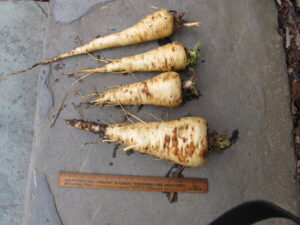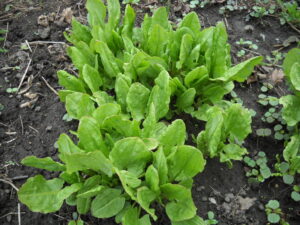Early Edibles from the Garden and Woods
Posted on Tuesday, April 14, 2020 · Leave a Comment
Okay, you may not want to go to the grocery store so much anymore. Tired of eating canned beans? Want something new for your taste buds? Here are some early things I look forward to each spring. These plants are all perennials, so if you don’t have them, you will need to plant them this year for future years.

Parsnips
Parsnips that I planted the previous spring are always one of my first garden treats. I harvest them as soon as the soil thaws. Yes, it’s an old fashioned vegetable, but it’s tasty if prepared properly and easy enough to grow.
Plant parsnip seeds in early summer for next spring’s fare. But if you have seeds saved from last year, don’t use them. Although most vegetable and flower seeds are good for 3 years, parsnip seeds are only good for one year – as are onion and parsley seeds.
Parsnips take an interminable time to germinate – 3 weeks, on average. The roots survive winters in the ground, but the seeds like warm soil to germinate. And as with most root crops, no one starts them indoors to get them going early. Just plant them in the ground in late May or early June. Thin to 2 or 3 inches between plants by the Fourth of July.
As to eating parsnips, don’t overcook them. Steam lightly or sauté them in butter and coat with maple syrup at the last minute. The syrup will glaze them and make the dish fit for a queen. You can cook them with carrots or add fennel seeds for a change of pace.
Next I go to my woods for a real treat: ramps. These are also called wild leeks, and are related to onions, leeks and garlic. They grow wild in moist, dark soil, often alongside streams in maple and beech forests. They often grow in huge swaths, thousands growing in one area. But they are slow growing, so don’t over-harvest them.

Ramps growing in my woods
For several years I dug up and planted about 50 ramps plants each year in my woods, and they have multiplied by offsets nicely. Two or three years ago I started harvesting seeds in late summer and sprinkling them on the soil and covering with just a little forest duff. These have grown and are doing nicely, though they are still too small to eat.
If you want to start some ramps in your woods, find a friend who will teach you how to recognize them. Ramps have pointed green leaves roughly the shape of a canoe and 6 to 9 inches long. They grow from a single point, each plant having 2 to 4 leaves. Frequently the base of the stem is maroon, but it may be green. And the key is this: they smell like garlic. You need to dig down 4 inches or so in the soil to harvest the bulbs, which slightly resemble leeks.
I use ramps the way I use onions – I add them to stir fries, scrambled eggs and stews. The nice thing is, you can eat the leaves, not just the little bulbs.
Another early spring treat is a perennial green called sorrel. Although seeds are available, I recommend buying plants at your local garden center if possible because it takes a long time to get big plants from seed. This plant’s leaves are very tart and almost lemon flavored.
When cooked, sorrel leaves cook down to almost nothing. Fortunately, I found a recipe in Deborah Madison’s fabulous cookbook, Vegetable Literacy, which takes advantage of sorrel’s sharp flavor, but mixes it in with other veggies to bulk it up. Here is what you can do:

Sorrel in early spring
Melt 1 tablespoon of butter in a pan, add 5 ounces of leeks (I always have some frozen from my garden) and 1 cup of water, and simmer 10 minutes covered on medium heat. Add 1.5 cups of peas and 3 cups water and simmer for 5 minutes. The stir in 2 to 3 cups sorrel, allow to wilt, and puree in a blender. Finally stir in a little cream, crème fraiche or yogurt.
The last of my early spring treats is another old fashioned one: rhubarb. Like sorrel, this has a tangy, sharp flavor. I love it in pies, tapioca pudding and jam. Some cooks spoil it by cooking with strawberries, but I feel that diminishes its flavor.
Rhubarb is easy to grow. You will need to buy plants or get roots from a friend – although rhubarb produces flowers stalks and seeds by the gazillion, it does not easily reproduce that way, though I’m told it can be done.
Amend the soil with lots of compost and/or aged manure. Add some organic fertilizer, too, as the roots will be in the same soil for decades – rhubarb lasts forever. I have some plants over 25 years old and going strong. Full sun is best, but like any leafy green it will produce in part shade. Four hours of sunshine will be fine.
One of my favorite rhubarb uses is to make punch. Chop up a few stems and boil in an equal quantity of water. Once it gets mushy you can strain it and add more water and some sugar until you have a nice drink. I just use a little sugar – I like the tea plenty tart. I like to use red stems for the tea, as it looks so nice in a glass or cup. Most people who grow rhubarb have plenty, so you might beg a few stalks if you don’t have your own – yet.





